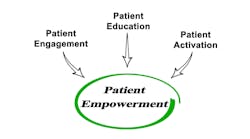At University Hospitals of Cleveland, Rethinking the Patient and Family Experience During COVID-19
As everywhere else in the U.S., the COVID-19 pandemic has had a major impact on hospitals and health systems in the Cleveland, Ohio metropolitan area. One of the many, many challenging elements in the pandemic has been difficult changes to the patient and family experience around care delivery—for example, the family members of inpatients being treated for COVID-19 who are unable to be allowed in-person access to their loved ones, because of obvious infection concerns.
In that context, Joan Zoltanski, M.D., the chief experience officer at the 17-hospital University Hospitals Health System, has been helping to lead her colleagues forward in addressing such concerns.
Among the innovations taking place at University Hospitals:
> In-room communication tools previously used only for clinical teams to communicate are now being put to new use to help patients stay connected to their loved ones when they can’t visit in person—either because of infectious disease concerns or for logistical reasons. By re-purposing those health IT tools, patients are able to stay connected to family members to provide emotional support and to participate in conversations with their doctors and nurses about ongoing plans of care.
> That same technology is also reducing the need for staff to go in and out of rooms where patients are in isolation by giving care teams a safe way to communicate with the patient or colleagues. This approach decreases infection risk, reduces the need for PPE changes, and facilitates care team communication—while also improving well-being for care teams by increasing efficiencies and reducing stress.
Dr. Zoltanski, who has practiced as a pediatric intensivist for 17 years and who continues to practice, has been chief experience officer at University Hospitals for five years. She spoke recently with Healthcare Innovation Editor-in-Chief Mark Hagland about these issues. Below are excerpts from that interview.
What has your organization’s experience of the pandemic been, and how has your organization’s experience led to your strategies around the patient and family experience?
In this context, what happened was that, over the years, we’ve had a pretty dramatic improvement in our patient experience scores over the past five years. Those improvements were built on bedside interactions as well as improvements in quality and safety. When COVID hit, we were trying to minimize the need for staff to enter rooms when it wasn’t medically necessary. We were also limiting visitors to slow exposure. When we thought about the basis of our patient experience, much of it was based on bedside interaction between clinicians and patients.
So we realized that this would be challenging, and also worried about infection. So I was adamant that we had to rethink the interactions but not stop them. And sometimes even if the nurse is on the other side of the door, we replaced those interactions with digital means. With doctors and nurses, there are fundamental daily practices we have that are… Many organizations stopped interactions, but we flipped them to digital. Every morning, the nurses come to the bedside and do the handoff at the bedside, in front of the patient. It supports safety. We have what we call “good catches,” and many of those happen at the moment of shift change. One nurse will remind the other nurse about developments. So when we couldn’t do it right in front of the patients, we modified it: the nurses are communicating on Vocera badges, and now the patient has a Vocera badge, too, to listen. Ten, fifteen years ago, we would do that at the nurses’ station. Over time, we changed that practice, about four or five years ago, where we brought the medical handoff into the room.
What were those processes like pre-COVID-19?
Previously, we would hand off medical information between nurses at the nurses’ station, and Nurse 1 would say, here’s what happened during the night. We did an x-ray, we had tests, etc. And the new nurse would say, here’s the plan for the day, and they exchanged information. And at that point of handoff is one of the points at which we have the biggest concerns around safety. And so now, often, the patient’s caregiver or loved one would be in the room, and they would be able to spot errors of information. And it also gives that person the ability to be “up” on what’s going to happen—OK, I’m going to get a CT scan and will be discharged at 3, for example.
So how many people are on Vocera, then, now?
The patient will have the Vocera in the room; the nurses can call in, do that report with the patient, and can also do that badge to also dial in the caregiver at home. So you can have the two nurses, patient and family, all on that shift report.
How has that worked out?
It gives us that chance to update the family. We don’t have visitors as frequently now, like many hospitals, we’ve restricted visitors. So people are very grateful to have that information; and oftentimes, the family member can catch things.
Have you been able to develop any metrics around outcomes yet?
We have reports on good catches. They’re oftentimes around a patient’s prescriptions, their history of medication lists, reactions to medications, etc. That’s one of the most common things that we catch.
Was this set of changes immediately accepted by everyone in the organization?
Many hospitals around suspended the practice, but I was adamant that we maintain it and change it. So it did require some work upfront. It does require a conversation with the family member—maybe, for example, the adult daughter. And the shift change happens at 7 in the morning and 7 in the evening, so we give them that choice. And we explain to them, we prepare them to hear medical information. So on admission, there’s some preparation work that has to be done at the front end.
And nurses have expressed satisfaction with the process and technology changes?
Yes, absolutely, that opportunity to engage with patients and family members. Further, there has been a gain in time, because the family members are clued in, so there isn’t the need for so many calls back and forth, and repeating the same information you just repeated to the nurse who’s oncoming. You’re not discussing it two times.
Have there been any technological complications?
We use Vocera, iPads, and different digital tools to make things happen. I’m always sensitive to the need for IT support to do all these things. And there’s been so much technology flooding into hospitals since April. And we’ve deployed IT into the hospital so it’s not just the nurse. We’re very sensitive to the fact that this shouldn’t fall to the nurses to troubleshoot. So many patients, so many devices. So the troubleshooting isn’t a nurse things.
Are there any other aspects of this that you might want to mention?
One other thing that I’m certainly talking about in our system now is that we like these technologies; we think they’re great for decreasing exposure to infection, and are decreasing the use of PPE [personal protective equipment] in the room. And this has to continue post-COVID; in reality, we shouldn’t have to have people physically in the hospital to be able to connect seamlessly with our nurses and doctors. And maybe a caregiver has to be at work, or at home, caring for their children. So our ability to engage that caregiver who’s not in the hospital—I think that’s been very beneficial for us, and I’m working to make sure that it stays in place post-COVID.


